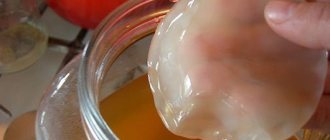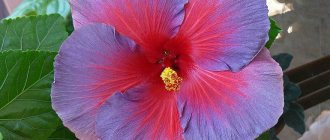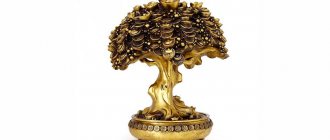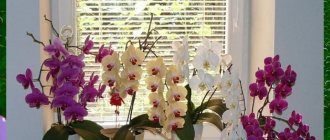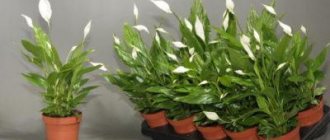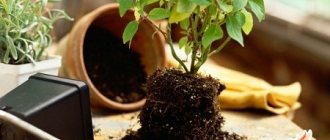Tradescantia belongs to the Commelinaceae . Widely distributed in nature in America.
The plant received its name in honor of the gardener John Tradescant, who served Charles I and was the first to describe this genus.
The plant belongs to the ampelous species and has creeping or straight stems. Tradescantia is very popular among flower growers due to its unpretentiousness and ease of forming and obtaining an attractive bush.
Tradescantia is also known for its beneficial properties, its ability to purify the air and neutralize electromagnetic radiation.
Selected types of Tradescantia:
Tradescantia zebrina, hanging.
Setcreasea or Tradescantia Pallida.
Reo or Tradescantia variegated
About caring for Tradescantia
Temperature: In spring and summer, a moderate temperature of 22-25°C is optimal; in winter it will withstand temperatures of at least 12°C. Tradescantia overwinters quietly even at normal room temperatures, if all care rules are followed.
Lighting: Prefers bright, diffused lighting, can withstand light shading. Variegated varieties are grown only in good light conditions, otherwise the color may suffer. Tradescantia is most suitable for eastern and western windows; varieties with monochromatic leaves also do well on northern windows. In summer, the plant can be moved to the garden, terrace or balcony, but you should choose a place well protected from direct sunlight and precipitation.
Watering: Tradescantia prefers abundant watering during the entire period of active growth from early spring to late summer, immediately after the top layer of soil dries out. Excess moisture from the pan is immediately drained. In winter, if the temperature is low, watering is reduced and done only after the soil for watering should be soft and settled.
Air humidity: Does not require high air humidity, does not require regular spraying. Grows well at normal humidity levels in apartments. In summer, it is recommended to give the plant a warm shower from time to time and spray it with a spray bottle.
Fertilizers : Apply special fertilizers for decorative deciduous plants 2 times a month. Varieties with monochromatic leaves are alternately fertilized with organic fertilizer. Variegated tradescantia are not fertilized with organic matter.
Soil: The plant is grown in special soil for tradescantia or for decorative foliage plants. A little vermiculite and pieces of charcoal are added to the soil, which will protect the roots from rotting.
Transplantation: Carried out together with pruning. Young Tradescantia are replanted annually in the spring, adult specimens once every 2-3 years. A thick layer of drainage is required at the bottom of the pot.
Pests: Can attack scale insects , spider mites , aphids and thrips .
Tradescantia sillamontana. ©David J. Stang
When and how to propagate hosta by dividing the bush
By dividing the bush, only an adult, healthy plant is propagated. The larger the bush, the more divisions you will get. To do this, dig up the entire bush. One plot should have several rosettes with leaves. They are planted at the same depth at which the parent plant grew. The distance between plantings should be maintained at about 30 cm. To ensure good survival, planted plants are watered abundantly and the soil around is mulched with sawdust or dry grass.
When to divide hosta? The best time to divide a bush:
- beginning of May;
- any month of summer;
- beginning of September.
Important! When dividing in the fall, minimal damage is caused to the plant, since the root system is at a dormant stage. The bush can be replanted when it is fully mature
A clear sign of the required seating is when the center of the crown begins to shrink
The bush can be replanted when it is fully mature. A clear sign of the required seating is when the center of the crown begins to shrink.
The bush can take up to five years to form. A young plant does not show its varietal characteristics; they appear as it grows. Therefore, frequent transplants are undesirable, since you may not be able to wait for the varietal characteristics of the hosta. You can divide the bush for the first time after 4-5 years.
How to split a hosta
Select the appropriate one from the gardening tools. It is better to work with a large bush with a shovel, with a small one - with a knife with teeth; with a large root, use a hacksaw (the cut is treated with ash or crushed coal in order to prevent rotting processes).
Before removing the plant from the ground, a circle with a diameter of 10 cm is cut around it if the bush is small, and 30-35 cm if the bush is large. Then they use a shovel to pry it under the root and carefully remove the plant with a lump of earth.
You need to divide the hosta carefully so as to damage the root system as little as possible. Small roots are carefully separated by hand, large seedlings are divided with a serrated knife.
Important! It is not the root that needs to be cut, but the base. Slow-growing varieties are best divided into large parts, while fast-growing varieties will grow even from one outlet
It is undesirable to divide the entire bush into more than four parts.
Slow-growing varieties are best divided into large parts, while fast-growing varieties will grow even from one outlet. It is undesirable to divide the entire bush into more than four parts.
Roots
Important! To see the entire root system, it can be washed with water before dividing. The plots are inspected for damage and diseases, and suspicious areas are removed.
The plots are inspected for damage and diseases, and suspicious areas are removed.
The soil is prepared either in the fall or a month before planting: it is dug up and fertilizers are added. Mineral fertilizers are added to poor soil.
The cuttings are planted at the same depth at which the parent plant grew. A little wood ash is poured into the bottom of the hole. The distance between plantings should be maintained at about 30 cm. To ensure good survival, planted plants are watered abundantly and the soil around is mulched with sawdust or dry grass.
At first, you can use mullein infusion as a top dressing. Be sure to periodically loosen the soil and remove weeds.
Note! Delenki cannot be planted in the old place, as the seedlings will take a long time to take root and will most likely die. You can get cuttings without digging up the entire bush
To do this, choose one or more strong sockets
They are dug up from the outside and carefully separated from the mother bush. The resulting void is filled with fertilizer, the plant is watered abundantly
The resulting division is first planted on a prepared bed for growing, and then transplanted to a permanent place
You can get cuttings without digging up the entire bush. To do this, choose one or more strong sockets
They are dug up from the outside and carefully separated from the mother bush. The resulting void is filled with fertilizer, the plant is watered abundantly
The resulting division is first planted on a prepared bed for growing, and then transplanted to a permanent place.
Division
Formation of the Tradescantia crown:
A prerequisite for growing is pruning Tradescantia. Without this type of care, it will quickly grow, stretch out and lose its attractive appearance. In the spring, after transplantation, all shoots of the plant are pinched, and those that are very elongated are cut to the required length.
Specimens that do not need replanting are cut and pinched in the same spring.
Tradescantia sillamontana. ©Michael Wolf
Transfer
On average, it is recommended to replant young Tradescantia annually after wintering. After the 5th year of life, the plant can change its pot or flowerpot less often - once every 2-3 years.
The most important two conditions for replanting are: prepare a shallow container and line the bottom of the pot with a wide layer of drainage.
A narrow container is needed because Tradescantia has a very underdeveloped root system. The larger the soil layer, the greater the chance of dampness and moisture stagnation. Waterlogged soil can be disastrous for Tradescantia, as the tender roots easily rot.
Also, the container must have holes made in the bottom to allow excess liquid to escape.
The drainage should be at least 2 cm wide. You can use layers of expanded clay and river sand.
The replanting process itself is best done using the transshipment method (although complete cleansing of the roots is fine). The plant is placed in the center of the new container and the sides are carefully sprinkled with new soil.
Methods for propagating Tradescantia at home
Seed propagation:
The seeds are sown in early spring on pre-moistened special soil for decorative foliage plants. The seeds are not deeply buried, covered with a greenhouse and placed in a bright, warm place at 20°C. In order for seedlings to appear as quickly as possible, the temperature must be stable, the greenhouse must be regularly ventilated and the soil must always be kept moist using a spray bottle.
Young Tradescantia must be protected from excessive waterlogging and drafts, since their root system is initially poorly developed. With proper care, they can bloom already in the 3rd year of life.
Cuttings, parts of the stem:
The fastest effective and optimal method of propagating tradescantia, which can be used at any time of the year. Typically, flower growers use cuttings obtained by pruning the plant in the spring for propagation. For successful rooting, the cutting must be 10-15 cm long; if it is longer, it can be divided into parts.
Cuttings quickly take root at a temperature of 15-20 °C both in water with the addition of activated carbon and in soil. 5-7 cuttings are planted in one pot at once in order to get a lush bush as quickly as possible.
Bush division:
Well-grown Tradescantia can be divided into parts. Such division is carried out only during transplantation, carefully, trying not to damage the roots once again, dividing the bush into parts with your hands. Each specimen is planted in a separate container and placed in place with the optimal temperature and absence of drafts.
Tradescantia navicularis. ©Salicyna
Brief description of the plant
The Tradescantia plant is native to North and South America. It has creeping stems and almost sessile leaves, reaching up to 7 cm in length. The leaf blades are ovoid in shape with yellow, white or red stripes. At the beginning of summer, small flowers appear, collected in umbellate or paniculate inflorescences. Flowering continues until autumn. Inflorescences are located on the top of the stems or in the axils of the leaves. Each flower blooms only for a day, but the inflorescence as a whole lives for quite a long time.
Indoor Tradescantia species bloom very rarely, usually in late spring or early summer. The plant has a number of beneficial properties that allow it to be used as a medicinal product. In indoor conditions, this flower cleanses the air of dust, tobacco smoke and other harmful compounds . Phytoncides found in the plant destroy viruses and microbes. These microorganisms are the causative agents of many diseases. The plant is considered unpretentious, so caring for a Tradescantia flower at home is not difficult.
How to plant and grow lavender at home in a pot
Growing problems:
- Yellow spots on the leaves appear when there is a lack of moisture in the soil;
- Sluggish shoots - insufficient watering;
- The variegated variety loses color if the plant does not have enough light intensity;
- Lack of growth, shoots stretch, leaves thin out due to lack of water, fertilizers, light;
- The tips of the leaves turn brown if the indoor humidity is too low;
- The leaves dry out and fall off at the base of the stem - the plant should be rejuvenated.
Views: 278
Landing
Before planting, it is always important to choose the right soil for the plant. But in the case of Tradescantia, this task is painfully simple - any soil will do. You can give preference to universal mixtures, simply use garden soil, or prepare the soil yourself by mixing:
- Leaf soil;
- Sod land;
- Humus;
- Coarse sand.
Everything is mixed in equal proportions.
It is only important to adhere to this rule: the soil for Tradescantia should be quite loose, easily allowing moisture and air to pass through.
